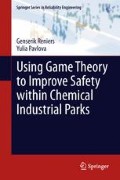Abstract
This chapter defines the objectives and the scope of the book. The differences between safety and security are explained, and the focus is determined to be cross-plant safety, which the book aims to tackle with the mathematical tools of game theory. The reader learns what exactly are chemical industrial parks, and how game theory may play an important role for cluster safety in such parks. A concise literature overview is also provided.
Access this chapter
Tax calculation will be finalised at checkout
Purchases are for personal use only
References
AIChE (American Institute of Chemical Engineers) (2000) Guidelines for chemical process quantitative risk analysis, 2nd edn. CCPS (Centre for Chemical Process Safety), New York
Antonioni G, Spadoni G, Cozzani V (2009) Application of domino effect quantitative risk assessment to an extended industrial area. J Loss Prev Process Ind 22(5):439–449
Bagster DF, Pitblado RM (1991) The estimation of domino incident frequencies—an approach. Process Saf Environ Prot 69(B):195–199
Bozzolan J.-C, Messias de Oliveira Neto J (2007) A study on domino effects in nuclear fuel cycle facilities. International Nuclear Atlantic Conference—INAC 2007, Santos, Brazil
Chew IML, Tan RR, Foo DCY, Chiu ASF (2009) Game theory approach to the analysis of inter-plant water integration in an eco-industrial park. J Cleaner Prod 17(18):1611–1619
Child J, Faulkner D, Tallman S (2005) Cooperative strategy: managing alliances, networks and joint ventures, 2nd edn. Oxford University Press, New York
Council Directive 96/82/EC on the control of major-accident hazards involving dangerous substances (1997) Off J Europ Union L010: 13–33
Council Directive 2003/105/EC (2003) Seveso II directive on the control of major-accident hazards involving dangerous substances with amendments. Off J Europ Union L345:97–105
Cozzani V, Gubinelli G, Salzano E (2006) Escalation thresholds in the assessment of domino accidental events. J Hazard Mater 129(1-3):1–21
Curzio AQ (2002) Dynamics and models in theory and practice. Physica-Verlag, Heidelberg
Delvosalle C (1996) Domino effects phenomena: definition, overview and classification. In: Direction Chemical Risks (ed) European seminar on domino effects. Federal Ministry of Employment, Brussels, pp 5–15
Delvosalle C (1998) A methodology for the identification and evaluation of domino effects. Rep. CRC/MT/003, Belgian Ministry of Employment and Labour, Brussels, Belgium
Gorrens B, De Clerck W, De Jongh K, Aerts M (2009) Domino effecten van en naar Seveso-inrichtingen. Rep. 07.0007, Flemish Ministry of Environment, nature and energy, Brussels, Belgium
HSE (Health and Safety Commission) (1984) The control of major hazards, third report of the HSC advisory committee on major hazards, HMSO, London
Khan FI, Abbasi SA (1998) Models for domino effect analysis in chemical process industries. Process Saf Prog 17(2):107–113
Lees FP (1996) Loss prevention in the process industries, 2nd edn. Butterworth-Heinemann, Oxford
Lo SM, Huang HC, Wang P, Yuen KK (2006) A game theory based exit selection model for evacuation. Fire Saf J 41(5):364–369
Nadeau S (2003) Cooperation in health and safety: a game theory analysis. Law Rev (Risks) 1(3/4):219–227
Post JG, Bottelberghs PH, Vijgen LJ, Matthijsen AJCM (2003) Instrument Domino Effecten. RIVM, Bilthoven
Reniers GLL (2010a) Multi-plant safety and security management in the chemical and process industries. Wiley-VCH, Weinheim
Reniers GLL (2010b) An external domino effects investment approach to improve cross-plant safety within chemical clusters. J Hazard Mater 177:167–174
Reniers GLL, Cremer K, Buytaert J (2011) Continuously and simultaneously optimizing an organisation’s safety and security culture and climate: the improvement diamond for excellence achievement and leadership in safety and security (IDEAL S&S). J Cleaner Prod 19(11):1239–1249
Straffin PD (1993) Game theory and strategy. The Mathematical Association of America, Washington DC
Xiao-Ping J, Fang W, Shu-Guang X (2009) Multi-objective game models for chemical industrial park. Comput Aided Chem Eng 27:2019–2024
Vallee A, Bernuchon E, Hourtolou D (2002) MICADO: Méthode pour l’identification et la caractérisation des effets dominos. Rep. INERIS-DRA-2002-25472, Direction des Risques Accidentels, Paris, France
Zhao R, Neighbour G, Han J, McGuire M, Deutz P (2012) Using game theory to describe strategy selection for environmental risk and carbon emissions reduction in the green supply chain. J Loss Prev Process Ind 25(6):927–936
Author information
Authors and Affiliations
Corresponding author
Rights and permissions
Copyright information
© 2013 Springer-Verlag London
About this chapter
Cite this chapter
Reniers, G., Pavlova, Y. (2013). Introduction: Why a Book on Game Theory for Safety Within the Chemical Industry?. In: Using Game Theory to Improve Safety within Chemical Industrial Parks. Springer Series in Reliability Engineering. Springer, London. https://doi.org/10.1007/978-1-4471-5052-7_1
Download citation
DOI: https://doi.org/10.1007/978-1-4471-5052-7_1
Published:
Publisher Name: Springer, London
Print ISBN: 978-1-4471-5051-0
Online ISBN: 978-1-4471-5052-7
eBook Packages: EngineeringEngineering (R0)

